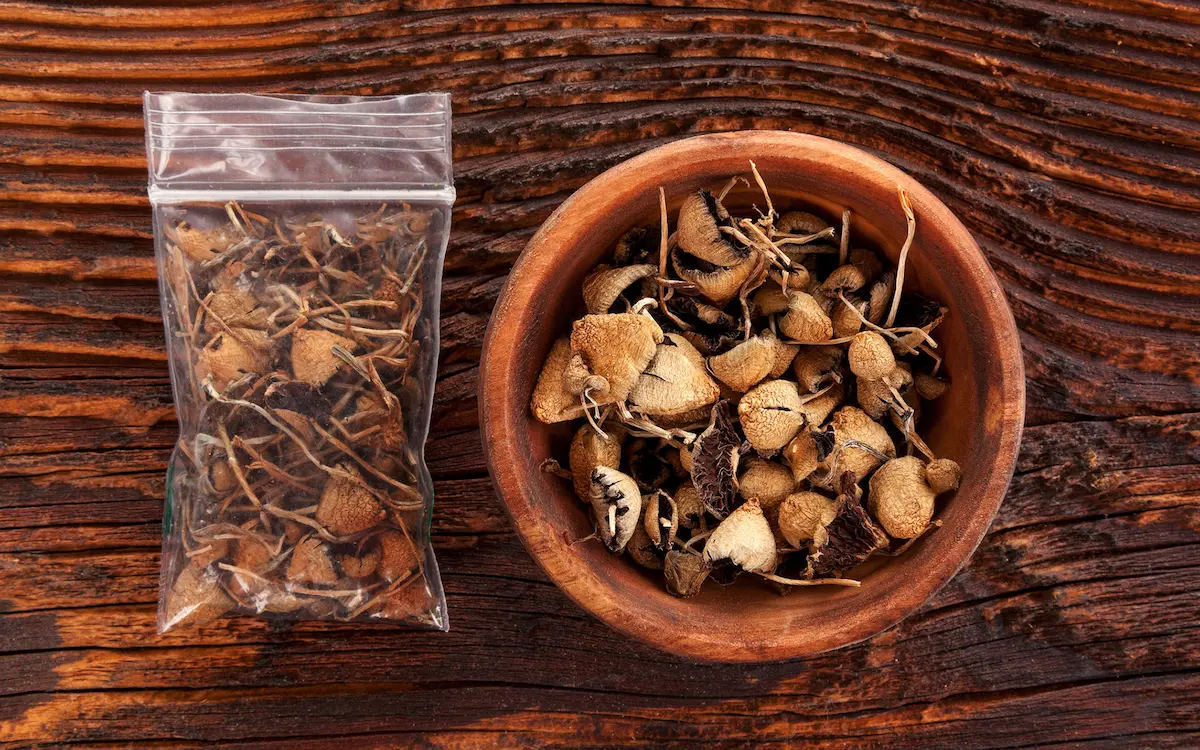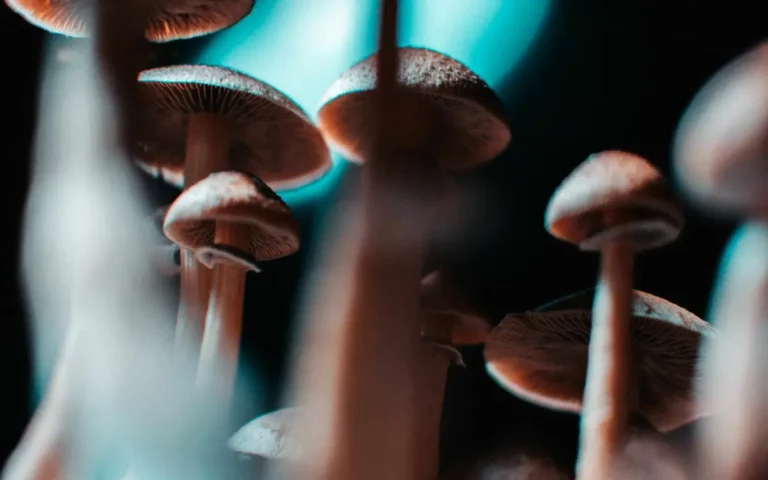The Paul Stamets Stack – Microdosing Psilocybin Mushrooms
What is Paul Stamets Stack?
In recent years, a captivating trend has emerged in the realm of health and wellness – the rise of mushroom supplements.
At the forefront of this movement is the renowned mycologist, Paul Stamets, whose innovative “Stamets Stack” has captured the attention of those seeking natural ways to enhance cognitive function, support immune health, and explore the therapeutic potential of fungi.
This blog post reaches into the history, research, and broader context surrounding this “Stack” and other mushroom protocols.
Microdosing Mushrooms
Microdosing mushrooms involves regularly taking very small, sub-perceptual doses of psychedelic mushrooms, typically containing the compound psilocybin.
Unlike traditional, larger doses that lead to pronounced hallucinations and altered states of consciousness, microdosing aims to harness the potential cognitive and mood-enhancing effects of psychedelics without the accompanying psychedelic experience.
Microdoses are usually a fraction of a typical recreational dose, often ranging from 1/10th to 1/20th of the amount that would induce noticeable hallucinations.
Advocates of microdosing claim various benefits, including increased creativity, improved mood, enhanced focus, and a greater sense of well-being. Some users also report potential long-term effects, such as improved emotional regulation and reduced symptoms of anxiety and depression.
It’s important to note that while anecdotal reports suggest positive outcomes, scientific research on the benefits and risks of microdosing mushrooms is still in its early stages.
Furthermore, the legality of using psychedelic substances, including mushrooms, varies widely, so individuals considering microdosing should be aware of and comply with relevant laws in their jurisdiction.
As with any substance use, caution, responsible dosing, and an understanding of individual tolerance and sensitivity are crucial. People interested in microdosing mushrooms should also be aware that individual responses can vary.
With all of that being said microdosing has become a popular intervention for those seeking alternatives to traditional SSRI’s and other pharmaceutical medications.
There are a handful of microdosing protocols each used to target specific benefits. Many more protocols are being proposed and some individuals have even chosen an intuitive protocol that works for them specifically.
Paul Stamets
First let’s get to know the man who has become a central figure in mycology.
With a lifelong passion for fungi, he has dedicated his career to studying the diverse and fascinating world of mushrooms. His work spans not only scientific research but also advocacy for the potential health benefits of certain mushroom species.
He has made significant contributions to the field of mycology through his research on various aspects of fungi. He is particularly recognized for his work on mycoremediation, which involves using mushrooms to break down and eliminate toxins and pollutants from the environment.
Stamets has been an advocate for the research of potential therapeutic applications of psilocybin. He has spoken about the potential of psilocybin in treating conditions like PTSD and anxiety, contributing to the growing interest in psychedelic research.
Mushrooms in Traditional Medicine
To contextualize the Stamets Stack, we must explore the historical use of mushrooms in traditional medicine.
Various cultures have incorporated mushrooms into their healing practices, recognizing their potential to address a range of health concerns.
The Renaissance of Mushroom Research
Across various cultures and civilizations, mushrooms have been revered for their potential healing properties.
From ancient Chinese medicine to indigenous practices in the Americas, mushrooms have played a role in supporting health and well-being.
Certain species, like Reishi and Cordyceps are believed to have immune-boosting and apoptogenic properties.
The Birth of the Stamets Stack
Paul Stamets envisioned a synergistic combination of these mushroom supplements, creating what is now known as the Stamets Stack.
This unique protocol aims to harness the potential benefits of Lion’s Mane, Niacin, and psilocybin-containing mushrooms in a complementary way.
Let’s break down this “Stack”, and understand the individual contributions of Lion’s Mane, Niacin, and psilocybin-containing mushrooms. Each element brings a unique set of compounds and potential health benefits to the table.
Lion’s Mane – Unleashing the Power of Nootropic Mushrooms
One of the key players in this “Stack” is the medicinal mushroom Lion’s Mane (Hericium erinaceus), a distinctive-looking fungus with cascading white spines that give it the appearance of a lion’s mane.
It is typically found on hardwood trees, particularly on dead or dying ones, and is native to North America, Europe, and Asia. This mushroom has gained attention for its potential health benefits, particularly in the realms of cognitive function and potential nootropic effects.
Nootropics are substances that may enhance cognitive function, and Lion’s Mane has been specifically touted for its ability to support nerve growth factor (NGF) production, crucial for the health and growth of nerve cells. Lion’s Mane is available in various forms, including fresh, dried, and as a supplement in powder or extract form.
Here are some key aspects to know about recent Lion’s Mane mushroom research:
- Lion’s Mane contains various bioactive compounds, including hericenones and erinacines, which are believed to contribute to its health-promoting properties.
- Lion’s Mane has been investigated for its neuroprotective effects, with studies suggesting potential benefits in conditions such as Alzheimer’s and Parkinson’s diseases.
- One of the most notable aspects of Lion’s Mane is its potential to support cognitive function. Some studies suggest that the bioactive compounds in Lion’s Mane may stimulate the production of NGF, a protein crucial for the growth, maintenance, and survival of nerve cells.
- Lion’s Mane has demonstrated anti-inflammatory and antioxidant properties, which are essential for overall brain health and may contribute to its neuroprotective effects.
- Inflammation and oxidative stress are implicated in various neurological disorders, and substances with anti-inflammatory and antioxidant properties are of interest in the field of neurobiology.
- Some preliminary studies suggest that Lion’s Mane may have potential benefits for mood and anxiety. These effects could be linked to its impact on nerve growth and the regulation of neurotransmitters. More research is needed to fully understand the impact of Lion’s Mane on mood and anxiety disorders.
- Lion’s Mane has been traditionally used in certain cultures to support digestive health. Some research suggests that the mushroom may have a positive impact on the gut microbiota, promoting a healthy balance of beneficial bacteria.
As with many natural remedies, Lion’s Mane continues to be an area of active research, and its potential benefits are still being explored.
While promising, more rigorous clinical studies are needed to establish its efficacy conclusively and to determine optimal dosages for specific health concerns.
Niacin
Niacin is the next component in the Stack. Niacin, also known as vitamin B3, is a water-soluble vitamin that plays a crucial role in various physiological processes in the body.
It is one of the essential B vitamins and is involved in energy metabolism, DNA repair, and the synthesis of certain hormones. Niacin exists in two main forms: nicotinic acid and nicotinamide. No relation to nicotine in tobacco.
In the context of psychedelic experiences, there is a phenomenon known as the “niacin flush.” This occurs when niacin is taken alongside psilocybin-containing mushrooms.
The niacin flush involves the dilation of blood vessels (vasodilation), leading to a warm, tingling sensation and reddening of the skin. Some individuals believe that the niacin flush enhances the overall experience by promoting increased blood flow and potentially affecting the intensity or nature of the effects.
It’s important to note that the use of niacin in conjunction with psychedelics, as seen in the Stamets Stack, is a matter of personal preference and may not be universally adopted or recommended.
The potential effects of the niacin flush on the experience are subjective, and individuals may have different responses to this combination. Sticking to a low dose is important (recommended: 20-50mg) and supplementing with a vitamin C and B complex. This way there the effects are not too intense.
In the research Niacin is currently claimed as the most effective medicine to increase high-density lipoprotein cholesterol. In a study performed in rats, Niacin was used to treat strokes and it had promoted plasticity and axon growth. This is similar to the effects that Lions’s Mane was showing.
Furthermore, while niacin itself is generally considered safe when used at recommended doses, it’s crucial to be aware of potential interactions with other medications or pre-existing health conditions.
Anyone considering the use of niacin or any supplement in combination with psychedelics should exercise caution, be well-informed, and ensure safety and suitability for their specific health situation.
Often taking niacin is not recommended if you have liver disease, stomach ulcers, alcoholism, very low blood pressure or have hypersensitivity to vitamin B3.
Psilocybin Mushrooms
The Stamets Stack also includes psilocybin-containing mushrooms, such as Psilocybe cubensis. Psilocybin undergoes conversion in the body to psilocin, which is responsible for the psychoactive effects.
Psilocybin mushrooms are famously associated with the archetypal psychedelic experience. There is a growing body of research exploring their potential therapeutic applications, particularly in the realm of mental health.
Our Psilocybin Retreat – Apply now!
The Controversy of Psilocybin
Though psilocybin’s inclusion in the Stamets Stack may raise eyebrows, psilocybin-containing mushrooms have a long history of traditional use in certain cultures.
Their potential therapeutic applications have sparked both excitement and controversy in the scientific and medical communities.
Challenges and Criticisms in Mushroom Research
While the potential benefits of mushroom supplements are intriguing, we cannot avoid the challenges and criticisms surrounding their use.
From limited scientific evidence to concerns about product quality, users should approach mushroom supplements with a discerning eye.
The Modern Revival of Mushroom Interest
As interest in natural and holistic approaches to health grows, mushrooms have experienced a renaissance in the wellness movement.
From culinary uses to supplement formulations, mushrooms have found their way into the daily routines of health enthusiasts worldwide.
Beyond Stamets – Other Notable Mushroom Protocols
While this “Stack” has gained popularity, it’s not the only approach to mushroom supplementation.
Exploring other protocols and combinations can provide a broader perspective on how mushrooms can be integrated into wellness routines.
Others include the Fadiman Protocol, the Every Other Day Protocol, the 2:1 Protocol, the Two Days a Week Protocol, and Intuitive Microdosing as mentioned earlier in the post.
Personal Experiences and Testimonials
One cannot overlook the power of personal experiences in shaping perceptions of mushroom supplements.
From enhanced cognitive function to improved mood, users share their stories of incorporating mushrooms into their daily lives.
Legal and Ethical Considerations
The legal status of certain mushrooms, particularly those containing psilocybin, varies widely.
Navigating the legal landscape and understanding the ethical implications of using these substances is crucial for responsible and informed supplementation.
Future Directions in Mushroom Research
What does the future hold for mushroom research?
From exploring new species to uncovering novel compounds, the scientific community is poised to unlock even more secrets within the vast kingdom of fungi.
Conclusion
In conclusion, the world of mushroom supplements is a captivating and evolving field.
From the pioneering work of Paul Stamets to the historical use of mushrooms in traditional medicine, the Stamets Stack is just one chapter in the story of fungi and their potential to support health and well-being.
As research continues and our understanding deepens, mushrooms may very well play a pivotal role in the future of medicine and holistic wellness.
Embracing the potential of nature’s fungi opens doors to a realm of possibilities, inviting us to explore, learn, and appreciate the intricate and ancient relationship between humans and mushrooms.
Our Psilocybin Retreat – Apply now!
References
- Cui, X., Chopp, M., Zacharek, A., Roberts, C., Buller, B., Ion, M., & Chen, J. (2010). Niacin treatment of stroke increases synaptic plasticity and axon growth in rats. Stroke, 41(9), 2044–2049.
https://doi.org/10.1161/STROKEAHA.110.589333 - Hiwatashi, K., Kosaka, Y., Suzuki, N., Hata, K., Mukaiyama, T., Sakamoto, K., Shirakawa, H., & Komai, M. (2010). Yamabushitake mushroom (Hericium erinaceus) improved lipid metabolism in mice fed a high-fat diet. Bioscience, biotechnology, and biochemistry, 74(7), 1447–1451.
https://doi.org/10.1271/bbb.100130 - Li, I. C., Chang, H. H., Lin, C. H., Chen, W. P., Lu, T. H., Lee, L. Y., Chen, Y. W., Chen, Y. P., Chen, C. C., & Lin, D. P. (2020). Prevention of Early Alzheimer’s Disease by Erinacine A-Enriched Hericium erinaceus Mycelia Pilot Double-Blind Placebo-Controlled Study. Frontiers in aging neuroscience, 12, 155.
https://doi.org/10.3389/fnagi.2020.00155 - Mori, K., Inatomi, S., Ouchi, K., Azumi, Y., & Tuchida, T. (2009). Improving effects of the mushroom Yamabushitake (Hericium erinaceus) on mild cognitive impairment: a double-blind placebo-controlled clinical trial. Phytotherapy research : PTR, 23(3), 367–372.
https://doi.org/10.1002/ptr.2634 - Mori, K., Obara, Y., Hirota, M., Azumi, Y., Kinugasa, S., Inatomi, S., & Nakahata, N. (2008). Nerve growth factor-inducing activity of Hericium erinaceus in 1321N1 human astrocytoma cells. Biological & pharmaceutical bulletin, 31(9), 1727–1732.
https://doi.org/10.1248/bpb.31.1727 - Nagano, M., Shimizu, K., Kondo, R., Hayashi, C., Sato, D., Kitagawa, K., & Ohnuki, K. (2010). Reduction of depression and anxiety by 4 weeks Hericium erinaceus intake. Biomedical research (Tokyo, Japan), 31(4), 231–237.
https://doi.org/10.2220/biomedres.31.231 - Rootman, J. M., Kryskow, P., Harvey, K., Stamets, P., Santos-Brault, E., Kuypers, K. P. C., Polito, V., Bourzat, F., & Walsh, Z. (2021). Adults who microdose psychedelics report health related motivations and lower levels of anxiety and depression compared to non-microdosers. Scientific reports, 11(1), 22479.
https://doi.org/10.1038/s41598-021-01811-4 - Rootman, J. M., Kiraga, M., Kryskow, P., Harvey, K., Stamets, P., Santos-Brault, E., Kuypers, K. P. C., & Walsh, Z. (2022). Psilocybin microdosers demonstrate greater observed improvements in mood and mental health at one month relative to non-microdosing controls. Scientific reports, 12(1), 11091.
https://doi.org/10.1038/s41598-022-14512-3 - Saitsu, Y., Nishide, A., Kikushima, K., Shimizu, K., & Ohnuki, K. (2019). Improvement of cognitive functions by oral intake of Hericium erinaceus. Biomedical research (Tokyo, Japan), 40(4), 125–131.
https://doi.org/10.2220/biomedres.40.125 - Vigna, L., Morelli, F., Agnelli, G. M., Napolitano, F., Ratto, D., Occhinegro, A., Di Iorio, C., Savino, E., Girometta, C., Brandalise, F., & Rossi, P. (2019). Hericium erinaceus Improves Mood and Sleep Disorders in Patients Affected by Overweight or Obesity: Could Circulating Pro-BDNF and BDNF Be Potential Biomarkers?. Evidence-based complementary and alternative medicine : eCAM, 2019, 7861297.
https://doi.org/10.1155/2019/7861297







